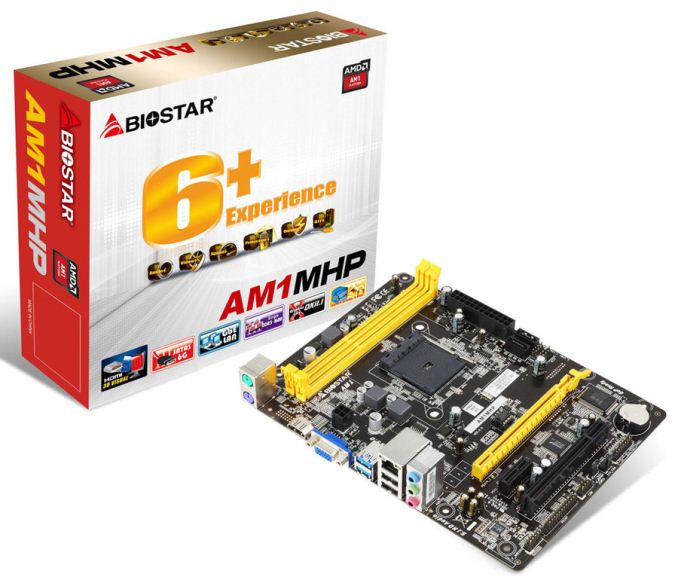The AM1 Kabini Motherboard Preview: Analyzing the Hardware
by Ian Cutress on April 19, 2014 2:00 PM ESTBiostar AM1MHP
Biostar’s other option for AM1 is a proper microATX motherboard that carries over many of the traits from the AM1ML. The DRAM slots are still at right angles to normal motherboard operation, and the 4-pin CPU power connector is next to the rear IO which will hinder cable management. The audio codec is also the same ALC662 codec we normally see on the ultra-low-end motherboards and laptops, but the network controller is upgraded to one that can support a gigabit connection.
The two SATA ports on the right hand side are both pointing in the same direction, suggesting that when using locking SATA cables the one on the left as seen might be hard to remove if the right port is populated. The BIOS chip is at least removable, should the unthinkable happen. With regards the memory slots, notice how (like the AM1ML) they are placed next to an empty space in the rear IO panel. Depending on the rear dust shield that comes with the motherboard, this server-type arrangement is usually performed to aid airflow from right to left across the components.
While the $35 GIGABYTE seems to have a preferential orientation and hardware allocation, the Biostar AM1MHP does have a PCI port that can be used to exploit older expansion cards.
The rear of the motherboard is identical to that of the GIGABYTE AM1M-S2H, except the HDMI port is now upside down. We still have both the PS/2 ports, the VGA port, two USB 3.0 ports, two USB 2.0 ports, a gigabit Ethernet port and the audio jacks.
| Biostar AM1MHP | |
| Price | Link |
| Size | Micro-ATX |
| CPU Interface | FS1b |
| Chipset | Kabini |
| Memory Slots |
Two DDR3 DRAM slots supporting 32GB Single Channel, 1333/1600 MHz |
| Video Outputs |
VGA HDMI |
| Onboard LAN | Realtek RTL8111G (10/100/1000) |
| Onboard Audio | Realtek ALC662 |
| Expansion Slots |
1 x PCIe 2.0 x16 (x4) 1 x PCIe 2.0 x1 1 x PCI |
| Onboard SATA/RAID | 2 x SATA 6 Gbps |
| USB 3.0 | 2 x USB 3.0 (Chipset) [back panel] |
| Onboard |
2 x SATA 6 Gbps 2 x USB 2.0 Headers 2 x Fan Headers 1 x LPT Header 1 x COM Header Front Audio Header Front Panel Header |
| Power Connectors |
1 x 24-pin ATX 1 x 4-pin CPU |
| Fan Headers |
1 x CPU (4-pin) 1 x SYS (3-pin) |
| IO Panel |
1 x PS/2 Mouse Port 1 x PS/2 Keyboard Port VGA HDMI 2 x USB 3.0 2 x USB 2.0 1 x Ethernet (1 Gbps) Audio Jacks (ALC662) |
| Product Page | Link |














64 Comments
View All Comments
JFish222 - Monday, April 21, 2014 - link
I agree, its disappointing that there is no ECC. (At least not listed.)I was really looking forward to using one of these for a low cost FreeNAS box.
Ian, Anand and company. Please encourage ECC bios support/validation! If any of the manufacturers support it (not always obvious when they do) please point it out.
For those that don't understand the importance, ZFS has numerous benefits but its greatest weakness is the ability to corrupt the entire data pool due to a flipped bit or 2 in RAM.
For more info - http://forums.freenas.org/index.php?threads/ecc-vs...
Chicken76 - Monday, April 21, 2014 - link
Indeed, Anandtech has the ear of motherboard manufacturers. They might respond positively if such suggestions are properly argumented. There's not only the enthusiast home user that these might be useful to, there's also the small businesses sector, where cost is a deciding factor. Add ECC support and a bit of validation for production use, and a lot of the cost-conscientious businesses will refresh their storage boxes and low workload machines using Kabini, instead of the Pentiums and Celerons they use now.rogueninja - Sunday, April 20, 2014 - link
Only bad friends recommend AMD.meacupla - Sunday, April 20, 2014 - link
Currently, AMD's most attractive CPU parts are the $60 A6-6400k and $120 FX-6300.Pentium and i3 have more single thread computing power, but looking at the entire package, AMD has some advantages at those price points.
Like a cheap 8 port SATA mobo, you can't have that with cheap LGA1150 boards.
or having 6 physical cores.
Antronman - Monday, April 21, 2014 - link
Except that when you're on a low budget, AMD is the only thing you should be recommending.Ortanon - Tuesday, April 22, 2014 - link
Intel usually wins low-budget too, haha. If you're talking "best gaming performance at the absolute bottom," yes, AMD wins. But who wants to game down there? As soon as you try to add any performance to your build whatsoever, it turns into an Intel solution with a PCIe GPU. It's possible that this would be different if all software was highly-threaded, but it just doesn't work out that way.AlB80 - Sunday, April 20, 2014 - link
Gigabyte's mobo has heatsink. What behind it? SuperIO?DuckieHo - Monday, April 21, 2014 - link
Biostar's mITX-Plus..... isn't that just AMD's DTX form factor?JBVertexx - Monday, April 21, 2014 - link
Stumbled across this - PC build in the motherboard box:https://www.youtube.com/watch?v=xngzjrKg3zI
WeatherDave - Monday, April 21, 2014 - link
"COM port, LPT port and a TPM port on the same PCB"We have about 50 machines here. Mostly for embedded testing, such as stepper motors, and old equipment that ONLY connects via Serial Port. USB converters are both unreliable and prone to failure, so we like having the COM ports on board. Besides, Windows 98/2000 and XP much prefer them over a converter. Now, we don't have much use for the LPT, but TPM and a cheap SSD certainly keeps IT Security off our backs.